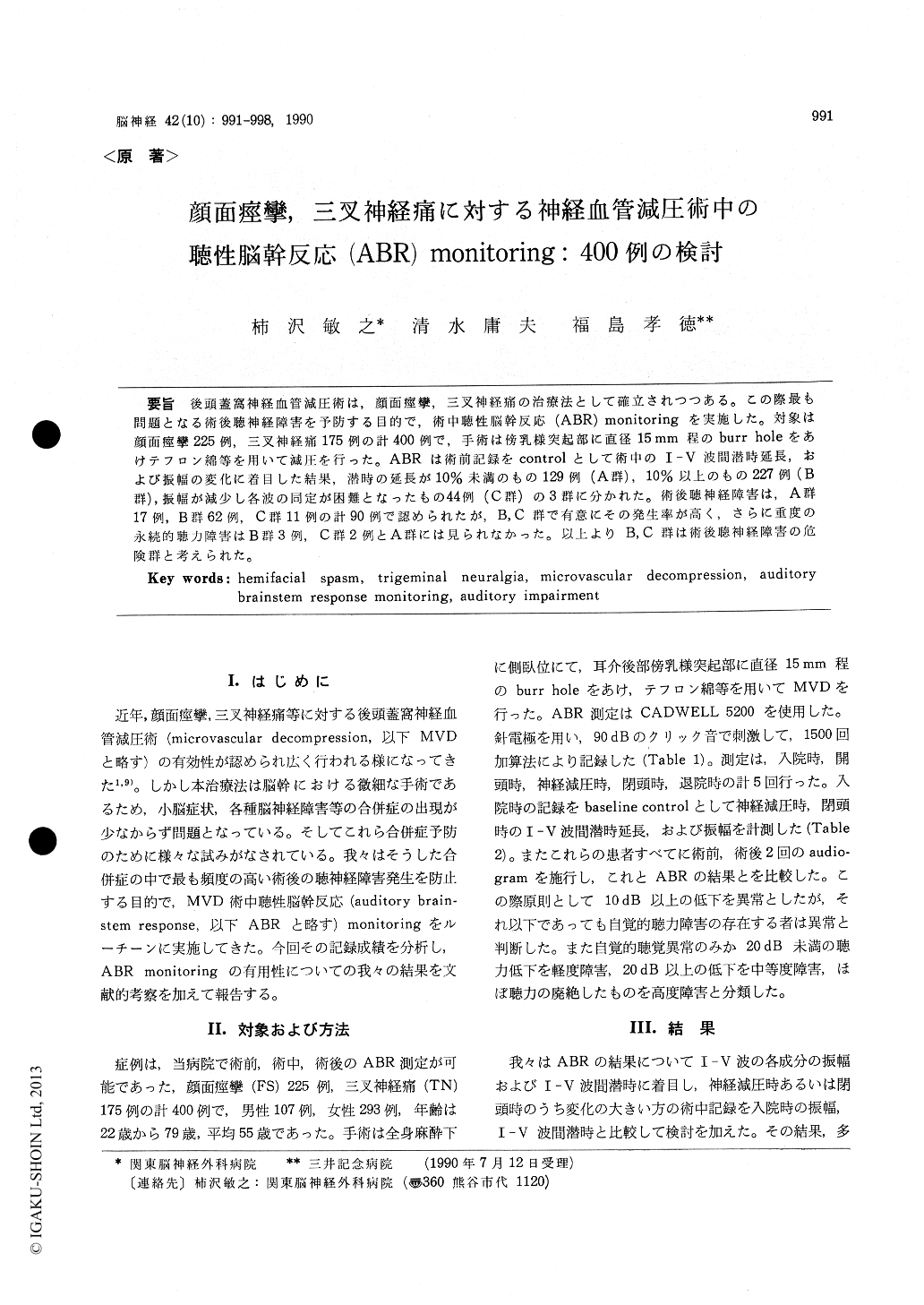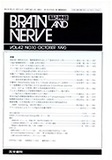Japanese
English
- 有料閲覧
- Abstract 文献概要
- 1ページ目 Look Inside
後頭蓋窩神経血管減圧術は,顔面痙攣,三叉神経痛の治療法として確立されつつある。この際最も問題となる術後聴神経障害を予防する目的で,術中聴性脳幹反応(ABR)monitoringを実施した。対象は顔面痙攣225例,三叉神経痛175例の計400例で,手術は傍乳様突起部に直径15mm程のburr holeをあけテフロン綿等を用いて減圧を行った。ABRは術前記録をcontrolとして術中のI—V波間潜時延長,および振幅の変化に着目した結果,潜時の延長が10%来満のもの129例(A群),10%以上のもの227例(B群),振幅が減少し各波の同定が困難となったもの44例(C群)の3群に分かれた。術後聴神経障害は,A群17例,B群62例,C群11例の計90例で認められたが,B,C群で有意にその発生率が高く,さらに重度の永続的聴力障害はB群3例,C群2例とA群には見られなかった。以上よりB,C群は術後聴神経障害の危険群と考えられた。
In recent years, microvascular decompression (MVD) has been well established as a definitive surgical procedure in the management of hemifa-cial spasm (HFS) and trigeminal neuralgia (TN). With careful microsurgical technique, MVD can be performed accurately without significant morbi-dity. However, some incidence of postoperative hearing disturbance has been reported as one the annoying complications.
In order to avoid complications of the 8th nerve, we have been using intraoperative monitoring of auditory brainstem response (ABR) for the past 5 years. This report presents the results of ABR monitoring in our personal series of 400 MVD cases.
Our clinical results consist of 225 HFS and 175 TN, who underwent recording of ABR before, during and after MVD, including audiometry be-fore and after the operation. There are 107 males and 293 females with the age raging between 22 and 79, averaging 55 years old.
Under routine general endotracheal anesthesia,the patient was placed in a lateral position and a small retromastoid opening was made. Pieces of teflon tape and fibrin glue was used to transpose, reposition and fixate the offending vessels.
We used CADWELL 5200 and recorded ABR with needle electrode and clic sound averaging 1500 times. ABR recordings were performed on admission, at the beginning of the operation, dur-ing nerve decompression and wound closure and at the time of discharge. The interpeak latency of waves I -V and the wave V amplitude during nerve decompression or wound closure were com-pared with those on admission.
ABR changes are classified into 3 categories : Type A indicates the delay of interpeak I -V latency to be within 10% of the preoperative con-trol, Type B designates the latency delay longer than 10%, and Type C means the disappearance of wave V. Of 129 cases with ABR changes oftype A, 17 cases had temporary hearing decrease. Of 227 cases with ABR changes of type B, 62 cases showed hearing disturbance (temporary 59, permanent 3). Type C changes were noted in 44 cases, in whom 11 had hearing impairment (tem-porary 9, permanent 2).
There were 13 unusual cases in whom the offen-ding arteries interposed between the proximal 7th and the 8th cranial nerves. In such instances 8 patients had postoperative auditory impairment including 3 deafness.
Based upon these data, it was concluded that utilization of ABR monitoring is very useful and that delay of I-V interpeak latency longer than 10% or disappearance of wave V might be con-sidered as the warning sign for postoperative auditory impairment in MVD surgery.

Copyright © 1990, Igaku-Shoin Ltd. All rights reserved.


